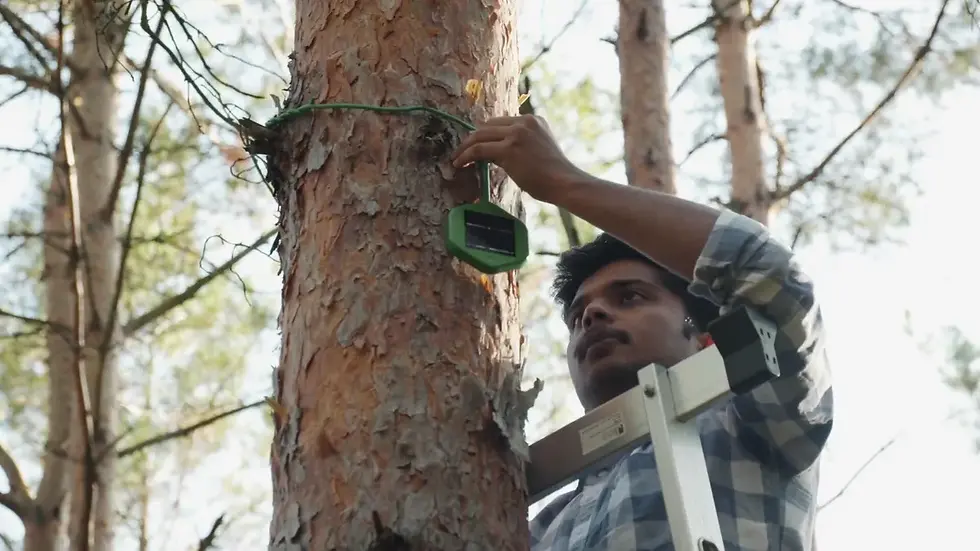Solar Wildfire Detectors
- SolarKobo

- Oct 16, 2023
- 3 min read
Introduction
Wildfires are a devastating force, both for the climate and for human communities. They destroy forests, homes, and businesses, and they can also have a significant impact on air quality and human health.
Wildfires are a global problem, and they are becoming more severe due to climate change. In 2022, there were an estimated 6.6 million hectares of tree cover lost to forest fires globally. Wildfires are responsible for up to 20% of global CO2 emissions. The emissions caused by wildfires create a vicious cycle of a hotter, dryer climate in some regions, leading to even more wildfires. According to the UN Environment Program, burned areas will increase by 62% if global temperatures increase by 2 degrees Celsius and to 97% if global temperatures increase by 3 points.
One of the biggest challenges in fighting wildfires is early detection. By the time a wildfire is visible from the ground, it is often too late to contain it. This is where solar wildfire detectors come in.

Solar Wildfire Detectors
Solar wildfire detectors are small, solar-powered devices that can be deployed in remote areas to monitor for signs of fire. They use a variety of sensors to detect changes in air quality, temperature, and humidity. If a solar wildfire detector detects smoke or other signs of fire, it can send an alert to firefighters, allowing them to respond quickly and extinguish the fire before it spreads.
Solar wildfire detectors are a relatively new technology, but they have the potential to revolutionize the way we fight wildfires. They are particularly useful in areas where it is difficult or expensive to deploy traditional fire detection systems.
One company that is developing solar wildfire detectors is Dryad Networks, an environmental IoT startup based in Berlin, Germany. Dryad Networks' Silvanet Wildfire Sensor is a small, off-grid device that can be mounted on trees. It measures temperature, humidity, air pressure, and air quality. If the sensor detects hydrogen, carbon monoxide, or other gases that are emitted during the early stages of a wildfire, it sends an alert to first responders.

How they Work
The sensors are compact, self-sustaining plastic units equipped with an integrated solar cell on their surface to provide power. These devices are multifunctional, capable of measuring temperature, humidity, air pressure, and boasting a low-power air quality sensor with a gas-sensing mode.
They are capable of identifying gases like hydrogen and carbon monoxide at ppm levels and at the smoldering stage, between 0-60 minutes. These gases are critical indicators of early pyrolysis stages, making them invaluable for wildfire detection.
Typically, these sensors are strategically positioned on trees at heights of 3 meters, optimizing their environmental monitoring capabilities. Each device has dimensions of 19 cm by 8.2 cm and features a 6 cm by 6 cm solar panel on its surface. Their robust design ensures durability, with an IP 67 rating for weather and UV resistance.
To reduce the risk of false positives, a pre-installed AI system trained on data acquired by controlled burning of various forest materials is used to train the system. These sensors are networked through gateways, with each gateway capable of hosting approximately 100 sensors, adaptable to the topography of the deployment area.
Data transmission relies on LoRaWan wireless technology, the dominant standard for IoT sensor systems, swiftly relaying critical information to first responders. They dispense with 4G/5G networks that cannot penetrate dense forests.
When the system picks up on a blaze, Dryad Networks uses its own communication network to send a signal to firefighters with the location of the threat.

Features
1. They are easy to deploy and maintain.
2. Each sensor can monitor an area about the size of a football field. This means that in order to be effective, they have to be made and deployed in large numbers. The sensors have already been deployed in parts of Europe and North America, and Dryad is currently focused on scaling up its operations.
3. They are self-powered, so they do not require any external power source.
4. They are environmentally friendly.
5. The sensors are made to be waterproof and store their energy in capacitors, rather than lithium-ion batteries that have some risk of catching fire themselves.
6. According to Dryad Networks, the device can run maintenance-free for up to 15 years, requiring no batteries and avoiding the use of lithium and other toxic or rare materials. Energy is instead stored in supercapacitors.

Conclusion
Dryad estimates that deploying 120 million of its sensors worldwide by 2030 could save up to 3.9 million hectares of forest from burning and prevent 1.7 billion tons of CO2 emissions.
Dryad Networks' Solar-Powered AI Wildfire Detection System is a testament to the convergence of advanced technology, sustainability, and global environmental responsibility. By combining early detection capabilities, AI precision, and reliance on renewable energy sources, this system represents a pivotal step towards mitigating the devastating effects of wildfires. Its technical sophistication positions it as a beacon of hope in safeguarding our natural world for generations to come.




best iptv : Welcome to Best IPTV 4K, your trusted destination for the best in IPTV streaming technology. We provide access to thousands of live TV channels, movies, and series in crystal-clear 4K Ultra HD, bringing you the ultimate entertainment experience directly to your screen.
At Best IPTV 4K, we believe in quality, stability, and simplicity. Our advanced IPTV system is designed to deliver smooth, high-speed streaming with zero buffering and perfect image quality. Whether you enjoy sports, movies, international TV, or kids’ channels, we offer a complete entertainment package to match every taste.
Our service is fully compatible with Smart TVs, Android Boxes, Fire Stick, PCs, tablets, and smartphones, giving you the freedom to enjoy your favorite content anytime, anywhere. We also…